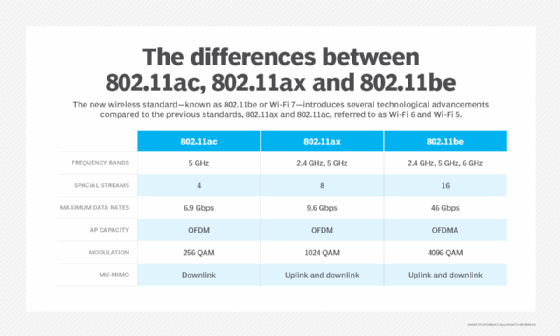802.11 standards: How do 802.11ac, 802.11ax, 802.11be differ?
Wi-Fi standards -- 802.11ac, 802.11ax and 802.11be -- differ based on frequency bands, spatial streams and maximum data rates, with 802.11be offering the most significant improvements.
Wireless standards documents can be hundreds of pages long and fraught with technical details. But the important highlights generally boil down to a short list of talking points that differentiate one standard from its predecessor.
The latest Wi-Fi standard is 802.11be, also known as Wi-Fi 7. It's worth comparing the new standard to its predecessors, 802.11ac and 802.11ax, known as Wi-Fi 5 and Wi-Fi 6, respectively. The 802.11be standard surpasses its predecessors in speeds, bandwidth capacity, data rates and more.
This article compares 802.11ac and 802.11ax with 802.11be to outline the important differences among the three specifications.
802.11ac vs. 802.11ax vs. 802.11be: Key differences
The 802.11 standards -- 802.11ac, 802.11ax and 802.11be -- differ in the following capabilities:
- Frequency bands.
- Spatial streams.
- Maximum data rates.
- Modulation.
Frequency bands
Both 802.11ac and 802.11ax support dual-band access points (APs). Although the term dual-band AP implies it can transmit signals from two frequency bands, 802.11ac mainly uses the 5 gigahertz (GHz) band. It can use the 2.4 GHz band, but this reflects a much older standard -- namely, 802.11n. The 802.11ax standard can provide both 2.4 GHz and 5 GHz.
The newer 802.11be specification, however, promises to exceed both standards. While 802.11ax can provide both 2.4 GHz and 5 GHz, 802.11be aims to go a step further to support the 6 GHz band as well.
The differences among the frequency bands of 802.11ac, 802.11ax and 802.11be are as follows:
- 802.11ac operates only in the 5 GHz band.
- 802.11ax works in the 2.4 GHz and 5 GHz bands.
- 802.11be uses the 2.4 GHz, 5 GHz and 6 GHz bands.
Spatial streams
The standards also differ in how many spatial streams they can support. Although the 802.11ac and 802.11ax standards could hypothetically support up to eight spatial streams, the hardware market stagnated at four. Most compatible APs and devices can't support more than four spatial streams in either specification.
The spatial streams of 802.11ac and 802.11ax are capped at half their theoretical capacity. Their successor, 802.11be, could potentially offer up to 16 spatial streams.
Maximum data rates
Due to hardware limitations, the 802.11ac standard never got close to delivering its maximum potential data rate of 6.9 Gbps. Its successor, 802.11ax, could deliver a higher theoretical maximum rate of 9.6 Gbps, but most users can't achieve those speeds in real-world situations.
The 802.11be standard promises to offer a significantly higher maximum of 46 Gbps. The large increase in 802.11be's projected data rates is thanks to its significant advancements over its predecessors. A well-designed Wi-Fi network typically provides better data rates at the same ranges and power levels as the technology teams are replacing. Essentially, users can expect better quality with the latest standard.

Modulation
All three specifications use quadrature amplitude modulation (QAM), a technique that determines the amount of data transmission each standard can support. Each new specification release experienced significant jumps in QAM capabilities:
- 802.11ac: 256 QAM.
- 802.11ax: 1024 QAM.
- 802.11be: 4096 QAM.
This increased modulation of 802.11be enables the standard to use more spectrum for data transfer and less for management.
Areas in which 802.11be improved include the following:
- Increased bandwidth.
- Advanced modulation.
- Multilink operation.
Compare 802.11 standards
Other significant developments among 802.11ac, 802.11ax and 802.11be include the following:
- Orthogonal frequency-division multiple access (OFDMA). Both 802.11ax and 802.11be primarily use OFDMA, which lets an AP service multiple wireless clients at different bandwidth requirements simultaneously. The 802.11ac standard supports the legacy orthogonal frequency-division multiplexing modulation method.
- Low power consumption. The 802.11ax specification included a new battery-preserving power-save methodology aimed at IoT devices. The 802.11be standard continues to reduce power consumption through features like Target Wake Time.
- Performance improvements. Compared with 802.11ac, both 802.11ax and 802.11be include bidirectional improvements in multiuser multiple input, multiple output radio processes. The 802.11be specification improves further with greater network capacity, faster speeds and improved bandwidth support.
- Basic service set (BSS) coloring. Both 802.11ax and 802.11be include a feature called BSS coloring, which deals with co-channel interference.
Despite their improvements, 802.11ac and 802.11be have no effective way to deal with interference from neighboring cells on the same channel, which can translate into reduced performance. BSS coloring adds a field to the wireless frame that overcomes issues associated with same-frequency cell coexistence, which increases overall capacity.
Editor's note: This article was updated to include information about 802.11be.
Lee Badman is a network architect specializing in wireless and cloud technologies for a large private university. He's also an author and frequent presenter at industry events.







